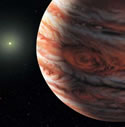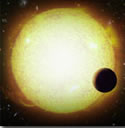An Earth-like planet could come together from a cloud of dust in as short as 3 million years according to a new report from researchers in Florida and Michigan. By studying the pre-planetary disks that form around other stars, the astronomers noticed that the disks form around young stars when they’re 1 million years old, but few stay longer than 3 million years, and none are present at 6 million years. This means that rocky planets, like the Earth, had to have formed during that time. Astronomers previously believed it took 10 million years for planets to form.
Furthest Extrasolar Planet Discovered
Astronomers from the Harvard-Smithsonian Center for Astrophysics announced today that they have discovered a Jupiter-class planet orbiting a star 5,000 light years away – the most distant ever found. The planet, called Ogle-TR-56b is important because it’s only the second planet ever discovered that passes directly in front of its star, dimming it slightly. More than 100 extrasolar planets have now been discovered. (BBC Article)
New Planetary System has Familiar Feel

Image credit: NASA
Planet hunters have discovered a new extrasolar system that looks remarkable like our own Solar System. Until now, planets orbiting around other stars have had elongated and eccentric orbits, but a planet orbiting around 55 Cancri has almost the same distance as our own Jupiter (although, it does have 3.5-5 times the mass). The team of astronomers also announced an additional 13 new planets on the same day, bringing the total number of known planets outside our Solar System to over 90.
After 15 years of observation and a lot of patience, the world’s premier planet-hunting team has finally found a planetary system that reminds them of our own home solar system.
Dr. Geoffrey Marcy, astronomy professor at the University of California, Berkeley, and astronomer Dr. Paul Butler of the Carnegie Institution of Washington, Washington, D.C., today announced the discovery of a Jupiter-like planet orbiting a Sun-like star at nearly the same distance as the Jovian system orbits our Sun.
“All other extrasolar planets discovered up to now orbit closer to the parent star, and most of them have had elongated, eccentric orbits. This new planet orbits as far from its star as our own Jupiter orbits the Sun,” said Marcy. NASA and the National Science Foundation fund the planet-hunting team.
The star, 55 Cancri in the constellation Cancer, was already known to have one planet, announced by Butler and Marcy in 1996. That planet is a gas giant slightly smaller than the mass of Jupiter and whips around the star in 14.6 days at a distance only one-tenth that from Earth to the Sun.
Using as a yardstick the 93-million mile Earth-Sun distance, called an astronomical unit or AU, the newfound planet orbits at 5.5 AU, comparable to Jupiter’s distance from our Sun of 5.2 AU (about 824 million kilometers or 512 million miles). Its slightly elongated orbit takes it around the star in about 13 years, comparable to Jupiter’s orbital period of 11.86 years. It is 3.5 to 5 times the mass of Jupiter.
“We haven’t yet found an exact solar system analog, which would have a circular orbit and a mass closer to that of Jupiter. But this shows we are getting close, we are at the point of finding planets at distances greater than 4 AU from the host star,” said Butler. “I think we will be finding more of them among the 1,200 stars we are now monitoring.”
The team shared its data with Dr. Greg Laughlin, assistant professor of astronomy and astrophysics at the University of California, Santa Cruz. His dynamical calculations show that an Earth-sized planet could survive in a stable orbit between the two gas giants. For the foreseeable future, existence of any such planet around 55 Cancri will remain speculative.
“The existence of analogs to our solar system adds urgency to missions capable of detecting Earth-sized planets – first the Space Interferometry Mission and then the Terrestrial Planet Finder,” said Dr. Charles Beichman, NASA’s Origins Program chief scientist at the agency’s Jet Propulsion Laboratory, Pasadena, Calif.
“This planetary system will be the best candidate for direct pictures when the Terrestrial Planet Finder is launched later this decade,” said UC Berkeley astronomer Dr. Debra A. Fischer.
Marcy, Butler, Fischer and their team also announced a total of 13 new planets today, including the smallest ever detected: a planet circling the star HD49674 in the constellation Auriga at a distance of .05 AU, one-twentieth the distance from Earth to the Sun. Its mass is about 15 percent that of Jupiter and 40 times that of Earth. This brings the number of known planets outside our solar system to more than 90.
Discovery of a second planet orbiting 55 Cancri culminates 15 years of observations with the 3-meter (118-inch) telescope at Lick Observatory, owned and operated by the University of California. The team also includes Dr. Steve Vogt, University of California, Santa Cruz; Dr. Greg Henry, Tennessee State University, Nashville; and Dr. Dimitri Pourbaix, the Institut d’Astronomie et d’Astrophysique, Universit? Libre de Bruxelles.
The star 55 Cancri is 41 light years from Earth and is about 5-billion years old. Further data are needed to determine whether yet another planet is orbiting it, because the two known planets do not explain all the observed Doppler wobbling. One possible explanation is a Saturn-mass planet orbiting about .24 AU from the star.
Original Source: NASA/JPL News Release
Looking for More Earths
One of the most exciting fields of research in astronomy is the search for extrasolar planets, and eventually the search for other Earth-like planets. So far more than 100 planets have been discovered, but none are remotely similar to our home. At a recent meeting of the Royal Astronomical Society, astronomers proposed criteria for searching for Earth-like planets, and even a few candidates. Unfortunately, the technology needed is still 15 years away.
Search for Planets Gets Closer to Home

Image credit: NASA
Locating the faint evidence of planets circling distant stars used to require high performance optics, like those on the Hubble Space Telescope, but two scientists are putting together a system for NASA that should do the trick with off-the-shelf components for less than $100,000. The system will watch a 5-degree square of sky continuously (about 100x the area of the full moon in the sky), searching for stars which “wink” regularly when a planet obscures it. (source: NASA/JPL)
It could fit on your desk, and it’s made mostly from parts bought at a camera shop, but two scientists believe their new instrument will help them find a slew of large planets orbiting stars in our Milky Way galaxy.
“An amateur astronomer could do this, except maybe for the debugging of the software, which requires several people working 10 hours a day,” said Dr. David Charbonneau of the California Institute of Technology in Pasadena. “But it’s easy to understand what’s going on and cheap to build the equipment. That’s why everyone thinks it’s an ideal project, if it works.”
The assembly of the new instrument is a cooperative effort between Charbonneau and Dr. John Trauger of NASA’S Jet Propulsion Laboratory in Pasadena, which is managed by Caltech. “David’s approach promises to locate new planets orbiting distant stars. The instrument is simple and straightforward, taking advantage of spare parts and computer code we already have on hand at JPL, and we hope to have it up and running in a few months,” Trauger said.
Charbonneau and his colleagues will soon use their gizmo to begin a three-year survey for extra-solar planets at Palomar Observatory in San Diego County. The instrument is based on a standard telephoto lens for a 35-millimeter camera. It will sweep the skies, looking for “hot Jupiters,” or large, gaseous planets, as their fast orbits take them in front of other stars, into the line of sight between a star and Earth. Astronomers will watch for the “wink” from the star as an orbiting planet partially blocks its light.
Charbonneau, a recent import to the Caltech astronomy staff from the Harvard-Smithsonian Center for Astrophysics, Cambridge, Mass., is a leading authority on the search for such “transiting planets.”
The new instrument uses a standard 300-millimeter Leica camera lens, with a charge-coupled device, or CCD. The CCD, which costs $22,000, will be mounted in a specially constructed camera housing to fit at the back of the lens. The entire device will be fitted onto an inexpensive equatorial mount, available at many stores carrying amateur astronomical equipment.
“Basically, the philosophy of this project is that, if we can buy the stuff we need off the shelf, we’ll buy it,” Charbonneau said. The project costs $100,000, a fraction of the cost of most large Earth and space-based telescopes.
The Palomar staff will provide a small dome for the instrument, and the system will be automated so it can be operated remotely. The new telescope will be linked with an existing weather system, which will monitor atmospheric conditions and determine whether the dome should be opened.
Charbonneau will be able to photograph a single square of sky about five degrees by five degrees. About 100 full moons or an entire constellation could fit in that field of view. With special software Charbonneau helped develop at Harvard-Smithsonian and the National Center for Atmospheric Research, he will compare many pictures of the same patch of sky to see if any of the thousands of stars in each field has “winked.”
If the software reveals a star has dimmed slightly, it could mean a planet passed in front of the star between exposures. Repeated measurements will allow Charbonneau to measure the orbital period and size of each planet. Further work with the 10-meter (33-foot) telescopes at Keck Observatory at Mauna Kea, Hawaii, will provide spectrographic data, and thus, will infer more detailed information about the planet.
Weather permitting, Charbonneau will gather up to 300 images a night. With 20 good nights per month, about 6,000 images would be gathered each month for computer analysis. The ideal time will be in the fall and winter, when the Milky Way is in view, and an extremely high number of stars can be squeezed into each photograph.
“It’s estimated that about one in three stars in our field of view will be like the Sun, and one percent of Sun-like stars have a hot Jupiter, or a gas giant that is so close to the star that its orbit is about four or five days,” Charbonneau said. “One-tenth of this 1-percent will be inclined in the right direction so that it will pass in front of the star, so maybe one in 3,000 stars will have a planet we can detect. Or if you want to be conservative, about one in 6,000.”
Original Source: NASA/JPL News Release
